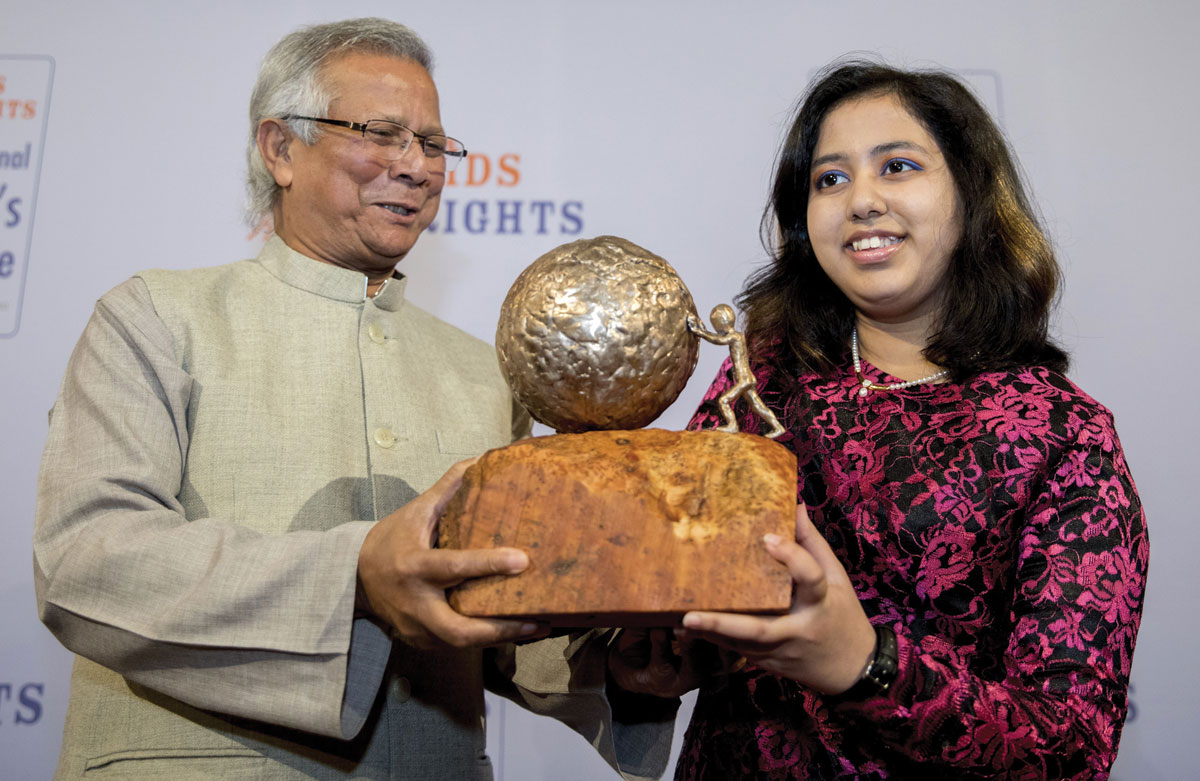INDIAN GIRL WINS INTERNATIONAL CHILDREN’S PEACE PRIZE
Indian teen environmental activist Kehkashan Basu (l), 16, receives the International Children’s Peace Prize 2016, from Nobel Peace Prize Winner Muhammad Yunus, at the Ridderzaal (Knight’s Hall) in The Hague, The Netherlands, Dec. 2. Basu is being honored for the work done by her child-run organization Green Hope, based in the United Arab Emirates and which has now more than 1,000 volunteers in 10 countries around the world. The intrepid teen founded Green Hope at the tender age of 12 and within four years managed several successful environmental projects, including planting 5,000 trees in countries as diverse as Colombia, France, Mexico, Nepal, Oman and the United States. (Jerry Lampen/AFP/Getty Images)
A 16-year-old Indian environmental activist based in the UAE has won this year’s prestigious International Children’s Peace Prize for her fight for climate justice and combating environmental degradation. – @Siliconeer #Siliconeer #India #KehkashanBasu #Environment #MuhammadYunus #GreenHope #KidsRights #UAE #YouthPlantingTrees
Kehkashan Basu was presented the award by Bangladesh’s Nobel peace laureate Mohammad Yunus at a glittering ceremony in The Hague.
Yunus, who won the Nobel Peace Prize in 2006 for his efforts for economic and social development, underlined the urgency and importance of Kehkashan’s work, as more than three million children under the age of five die every year from environment-related diseases and many more suffer deeply from environmental issues.
“It is a great achievement for such a young person to already have such reach and impact with her important message,” Yunus said.
“A healthy environment is essential for the survival, wellbeing and development of children, and therefore it is a precondition for the realization of the rights of the child.
Kehkashan teaches us that we all have a responsibility to work towards a sustainable future,” he said.
After receiving the prize, Basu said she would “keep campaigning to encourage children and adults to create a more sustainable future.”
“I call upon everyone to think of how they can contribute to the preservation of the environment … time is not on our side we have to act now, or we will have polar bears under palm trees,” she said.
When Kehkashan was eight, she started educating neighbors on the importance of saving the environment. She planted her first tree and brought together children to collect and recycle waste, according to KidsRights Foundation that has instituted the award.
She founded her organization Green Hope at the age of twelve, through which she has initiated countless cleanup operations and awareness campaigns.
Kehkashan then became the youngest ever Global Coordinator for the Major Group for Children and Youth of the United Nations Environmental Program.
Green Hope has become an international organization with activities in more than ten countries and over a thousand young volunteers.
Basu was nominated for the Children’s Peace Prize by her father and was selected for the award from among 120 nominees from 49 countries.
The International Children’s Peace Prize is an initiative of Marc Dullaert, Chairman and Founder of the Dutch KidsRights Foundation, and is awarded annually to a child, anywhere in the world, for his or her dedication to children’s rights.
The winner receives the statuette ‘Nkosi,’ which shows how a child sets the world in motion.
The winner also receives a study and care grant and a worldwide platform to promote his or her ideals and causes to the benefit of children’s rights.
Furthermore, a project fund of 100,000 euros is invested by KidsRights in projects that are closely connected to the winners’ area of work in the country of the winner.
The schoolgirl won because she had proved her ability to start a movement with real impact, said Dullaert.
The Amsterdam-based global children’s aid group runs the award program, which started in 2005.
“Kehkashan has managed to mobilize thousands of children to protect the environment,” said Dullaert.
“Children are the most vulnerable group and, without exception hit the hardest during environmental crises. They are, for example, the most vulnerable to water and air pollution. Children’s rights and environmental development are inextricably linked,” he said.


